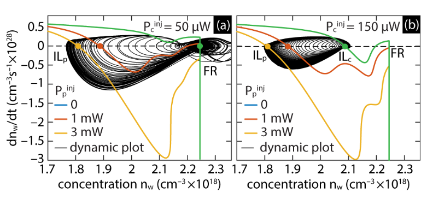As artificial intelligence becomes an essential part of our daily lives, the need for faster and more energy-efficient hardware continues to grow. In our latest research, conducted as part of the now-completed ORCA-LAB project, we explored how photonics—using light instead of electricity—can address these challenges.
We focused on a key component of optical neural networks: 𝗮𝗰𝘁𝗶𝘃𝗮𝘁𝗶𝗼𝗻 𝗳𝘂𝗻𝗰𝘁𝗶𝗼𝗻𝘀, which help the network learn and make decisions. This work demonstrates how 𝗙𝗮𝗯𝗿𝘆-𝗣𝗲𝗿𝗼𝘁 𝗹𝗮𝘀𝗲𝗿 𝗱𝗶𝗼𝗱𝗲𝘀 (FP-LDs) can serve as 𝗳𝘂𝗹𝗹𝘆 𝗼𝗽𝘁𝗶𝗰𝗮𝗹, 𝗽𝗿𝗼𝗴𝗿𝗮𝗺𝗺𝗮𝗯𝗹𝗲 𝗮𝗰𝘁𝗶𝘃𝗮𝘁𝗶𝗼𝗻 𝘂𝗻𝗶𝘁𝘀—a capability that has long been out of reach.
Through simulations and experiments, we showed that these lasers respond to very short optical pulses (as short as 25 picoseconds) in complex and tunable ways. By adjusting experimental parameters—such as injecting a secondary laser—we were able to reproduce activation functions like 𝘀𝗶𝗴𝗺𝗼𝗶𝗱 𝗮𝗻𝗱 𝗣𝗥𝗲𝗟𝗨, entirely in the optical domain.
Importantly, our solution works at high speeds (up to 10 GHz) and with extremely low energy consumption—down to hundreds of femtojoules per operation—making it a promising building block for future 𝘂𝗹𝘁𝗿𝗮𝗳𝗮𝘀𝘁 𝗮𝗻𝗱 𝗲𝗻𝗲𝗿𝗴𝘆-𝗲𝗳𝗳𝗶𝗰𝗶𝗲𝗻𝘁 𝗽𝗵𝗼𝘁𝗼𝗻𝗶𝗰 𝗻𝗲𝘂𝗿𝗮𝗹 𝗻𝗲𝘁𝘄𝗼𝗿𝗸𝘀.
Although the ORCA-LAB project has officially concluded, we are continuing to build on these results and explore their full potential in upcoming research activities.
📄 Read the full paper here
